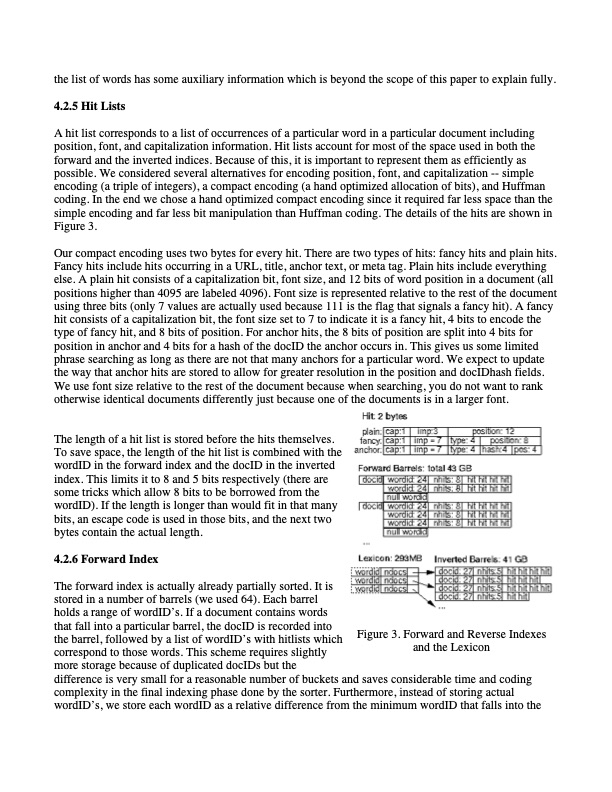
PDF Publication Title:
Text from PDF Page: 009
the list of words has some auxiliary information which is beyond the scope of this paper to explain fully. 4.2.5 Hit Lists A hit list corresponds to a list of occurrences of a particular word in a particular document including position, font, and capitalization information. Hit lists account for most of the space used in both the forward and the inverted indices. Because of this, it is important to represent them as efficiently as possible. We considered several alternatives for encoding position, font, and capitalization -- simple encoding (a triple of integers), a compact encoding (a hand optimized allocation of bits), and Huffman coding. In the end we chose a hand optimized compact encoding since it required far less space than the simple encoding and far less bit manipulation than Huffman coding. The details of the hits are shown in Figure 3. Our compact encoding uses two bytes for every hit. There are two types of hits: fancy hits and plain hits. Fancy hits include hits occurring in a URL, title, anchor text, or meta tag. Plain hits include everything else. A plain hit consists of a capitalization bit, font size, and 12 bits of word position in a document (all positions higher than 4095 are labeled 4096). Font size is represented relative to the rest of the document using three bits (only 7 values are actually used because 111 is the flag that signals a fancy hit). A fancy hit consists of a capitalization bit, the font size set to 7 to indicate it is a fancy hit, 4 bits to encode the type of fancy hit, and 8 bits of position. For anchor hits, the 8 bits of position are split into 4 bits for position in anchor and 4 bits for a hash of the docID the anchor occurs in. This gives us some limited phrase searching as long as there are not that many anchors for a particular word. We expect to update the way that anchor hits are stored to allow for greater resolution in the position and docIDhash fields. We use font size relative to the rest of the document because when searching, you do not want to rank otherwise identical documents differently just because one of the documents is in a larger font. The length of a hit list is stored before the hits themselves. To save space, the length of the hit list is combined with the wordID in the forward index and the docID in the inverted index. This limits it to 8 and 5 bits respectively (there are some tricks which allow 8 bits to be borrowed from the wordID). If the length is longer than would fit in that many bits, an escape code is used in those bits, and the next two bytes contain the actual length. 4.2.6 Forward Index The forward index is actually already partially sorted. It is stored in a number of barrels (we used 64). Each barrel holds a range of wordID’s. If a document contains words that fall into a particular barrel, the docID is recorded into the barrel, followed by a list of wordID’s with hitlists which correspond to those words. This scheme requires slightly more storage because of duplicated docIDs but the difference is very small for a reasonable number of buckets and saves considerable time and coding complexity in the final indexing phase done by the sorter. Furthermore, instead of storing actual wordID’s, we store each wordID as a relative difference from the minimum wordID that falls into the Figure 3. Forward and Reverse Indexes and the LexiconPDF Image | natomy of a Large-Scale Hypertextual Web Search Engine

PDF Search Title:
natomy of a Large-Scale Hypertextual Web Search EngineOriginal File Name Searched:
google-anatomy-of-a-search-engine.pdfDIY PDF Search: Google It | Yahoo | Bing
Cruise Ship Reviews | Luxury Resort | Jet | Yacht | and Travel Tech More Info
Cruising Review Topics and Articles More Info
Software based on Filemaker for the travel industry More Info
The Burgenstock Resort: Reviews on CruisingReview website... More Info
Resort Reviews: World Class resorts... More Info
The Riffelalp Resort: Reviews on CruisingReview website... More Info
| CONTACT TEL: 608-238-6001 Email: greg@cruisingreview.com | RSS | AMP |